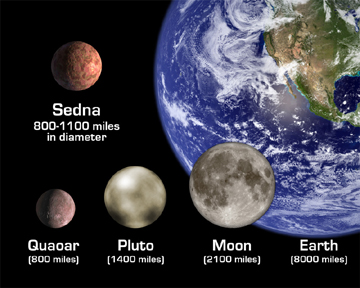Geotimes

Web Extra
Tuesday, March 16, 2004
Sedna: Newly sighted planetoid
in the solar system
 At the edge
of the solar system, astronomers have unexpectedly sighted an object slightly
smaller and farther from the Sun than Pluto — not quite another planet,
but not a temporary visitor either. Announcing the discovery yesterday, a team
of scientists led by Michael Brown of Caltech in Pasadena, Calif., said the
object is a planetoid — an asteroid that resembles a planetary body.
At the edge
of the solar system, astronomers have unexpectedly sighted an object slightly
smaller and farther from the Sun than Pluto — not quite another planet,
but not a temporary visitor either. Announcing the discovery yesterday, a team
of scientists led by Michael Brown of Caltech in Pasadena, Calif., said the
object is a planetoid — an asteroid that resembles a planetary body.
Artist's rendering compares the three
smallest and most distant planetoids in the solar system — Quaoar, the
newly sighted Sedna and Pluto — with Earth and the Moon. Image courtesy
of Caltech/NASA.
The discoverers have proposed naming the body Sedna, after an Inuit goddess
of the sea. Its relatively erratic orbit takes 10,500 years, and at its farthest
point, it is 130 billion kilometers away from the Sun. (Earth is about 150 million
kilometers from the Sun, and Pluto, almost 6 billion kilometers away.)
Brown's team has hypothesized that the small red planetoid may be the first
object ever sighted from the Oort Cloud. The large assemblage of comets sits
much farther outside the solar system than the planetoid's orbit. Other scientists
noted the object could be a captured part of the Kuiper Belt, a disk of icy
comets near Neptune's orbit. For more information, follow the links below.
Links:
NASA
article on Sedna
Sedna
home page of principal investigator Michael Brown of Caltech
Link
to movie of Sedna's orbit from Caltech (large file: 15 M)
A comparison of orbits in the Solar System (courtesy of Caltech/NASA)
Back to top
 At the edge
of the solar system, astronomers have unexpectedly sighted an object slightly
smaller and farther from the Sun than Pluto — not quite another planet,
but not a temporary visitor either. Announcing the discovery yesterday, a team
of scientists led by Michael Brown of Caltech in Pasadena, Calif., said the
object is a planetoid — an asteroid that resembles a planetary body.
At the edge
of the solar system, astronomers have unexpectedly sighted an object slightly
smaller and farther from the Sun than Pluto — not quite another planet,
but not a temporary visitor either. Announcing the discovery yesterday, a team
of scientists led by Michael Brown of Caltech in Pasadena, Calif., said the
object is a planetoid — an asteroid that resembles a planetary body. 
